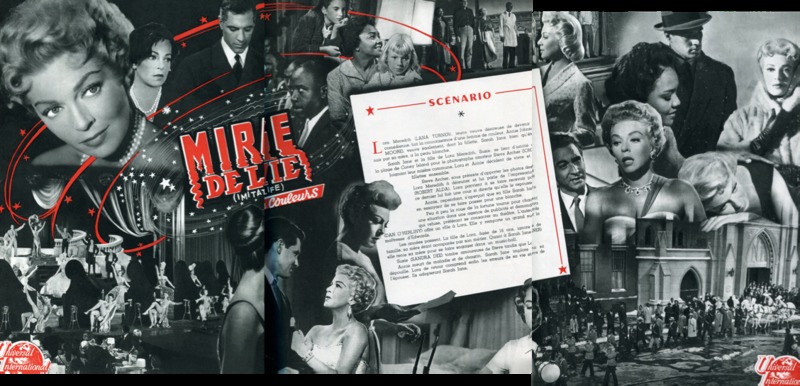Imitation of Life
Dublin Core
Title
Description
The inside spread of a French press book allows a lens through which to view themes of race and passing in Imitation of Life. This press book was for the 1959 French adaptation of the film. Notably, most of the images feature Lana Turner, the actress who is the white female lead in the film, Lora Meredith. Although Sarah Jane is a secondary character, her struggle with her racial identity is a central theme to the film. While the conflicts surrounding Sarah Jane’s passing are salient, a viewer would not be able to tell that the film explored passing by merely looking at the images in the spread. In fact, only one image in the collage shows Susan Kohner as Sarah Jane Johnson. The remaining images center on Turner as Lora Meredith, and she appears in the spread both alone and interacting with various other characters. The single image that shows Kohner is in the bottom left corner of the spread. The image is from the scene in which, after running away from her home to distance herself from her dark-skinned mother, Sarah Jane works as a chorus girl in California, which is made possible by her ability to pass for white. Its location in the spread, as well the lack of visibility of Kohner’s face, reflect the insignificance of Sara Jane’s plotline in the advertisement.
bell hooks’ concept of the oppositional gaze is useful in interpreting this image in the context of the film. The oppositional gaze explains how black women can have trouble with the absence of pleasurable black female characters and actively analyze a film instead of passively accepting it. The selected image, as well as the film itself, lack representation of non-stereotypical Black women. Annie Johnson represents a mammy stereotype, and Sarah Jane’s character follows the tragic mulatto trope (Thaggert 488). In fact, Imitation of Life prompted hooks to temporarily reject and distance herself from film. Addressing Sarah Jane in her essay, “The Oppositional Gaze: Black Female Spectators,” hooks says, “There was something scary in this image of young sexual sensual black beauty betrayed- the daughter who did not want to be confined by blackness, that ‘tragic mulatto’ who did not want to be negated” (hooks 112). Ultimately, the absence of a black character in Imitation of Life with whom Black female spectators can pleasurably connect helped hooks construct her ideas about the oppositional gaze.
The chorus girl scene in the spread reflects the spectacle of Sarah Jane’s character throughout the film, both as a subject of the audience’s spectatorship and of the white characters’ spectatorship. During each of the times Annie seeks to understand Sarah Jane’s desire to occupy a white world, white spectatorship is prominent in their interactions. When Annie brings Sarah Jane boots and a raincoat to school and reveals Sarah Jane’s true ancestry, Annie’s search for Sarah Jane in the classroom occurs under the gaze of the white teacher and the other students, who are all white. When Annie finds Sarah Jane singing and dancing at the nightclub, Annie first watches Sarah Jane through a slat of wood, and then Sarah Jane’s white boss watches Annie’s confrontation of Sarah Jane. Even when Annie comes to California, she first watches Sarah Jane, and the intruding presence and gaze of Sarah Jane’s white friend interrupts their later interaction in Sarah Jane’s motel room. Sarah Jane is constantly under the gaze of both the audience and the white characters in the film, reinforcing the concept of the gaze with which white society views black womanhood. Sarah Jane’s struggle with her identity and the discussions surrounding passing in the film reflect the spectacle of black womanhood, but also demand the oppositional gaze of black female spectators.
Herrera, Brian. “StinkyLulu: Susan Kohner in The Imitation of Life (1959) - Supporting Actress Sunday.” StinkyLulu. N.p., 22 Apr. 2009. Web. 30 Apr. 2015.
hooks, bell. “The Oppositional Gaze: Black Female Spectators.” Black Looks: Race and Representation. Boston: South End Press, 1992. 115–131. Print.
Johnson Gosselin, Adrienne. “Racial Etiquette and the (White) Plot of Passing: (Re)Inscribing ‘Place’ in John Stahl’s Imitation of Life.” Canadian Review of American Studies, 28.3 (1998): 47–68. CrossRef. Web. 30 Apr. 2015.
Russell, Margaret. “Race and the Dominant Gaze: Narratives of Law and Inequality in Popular Film.” 15 Legal Stud. F. 243 (1991): n. pag. Web.
Smith, Valerie. “Reading the Intersection of Race and Gender in Narratives of Passing.” Diacritics 24.2/3 (1994): 43–57. Print.
Thaggert, Mirian. “Divided Images: Black Female Spectatorship And John Stahl’s Imitation Of Life.” African American Review 32.3 (1998): 481–491. Print.
